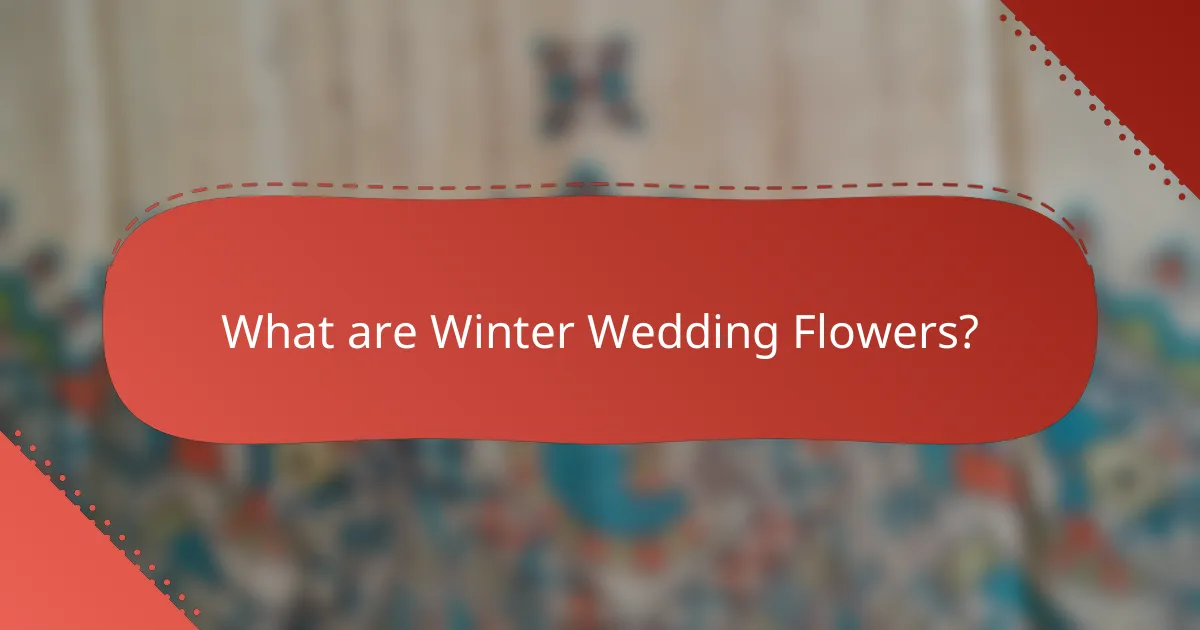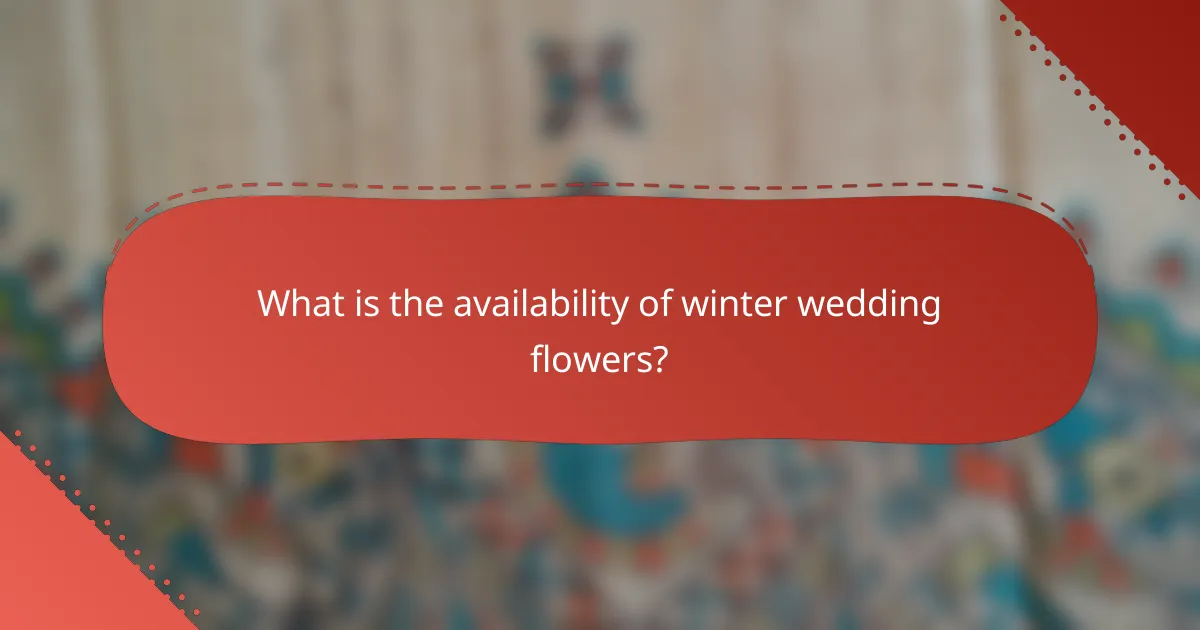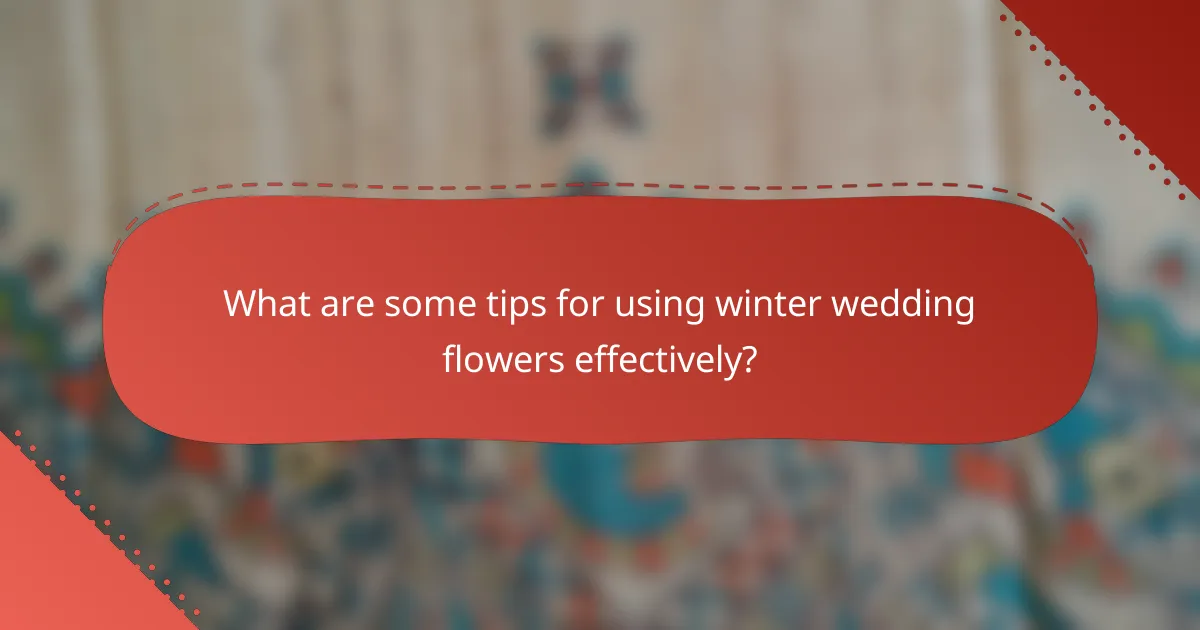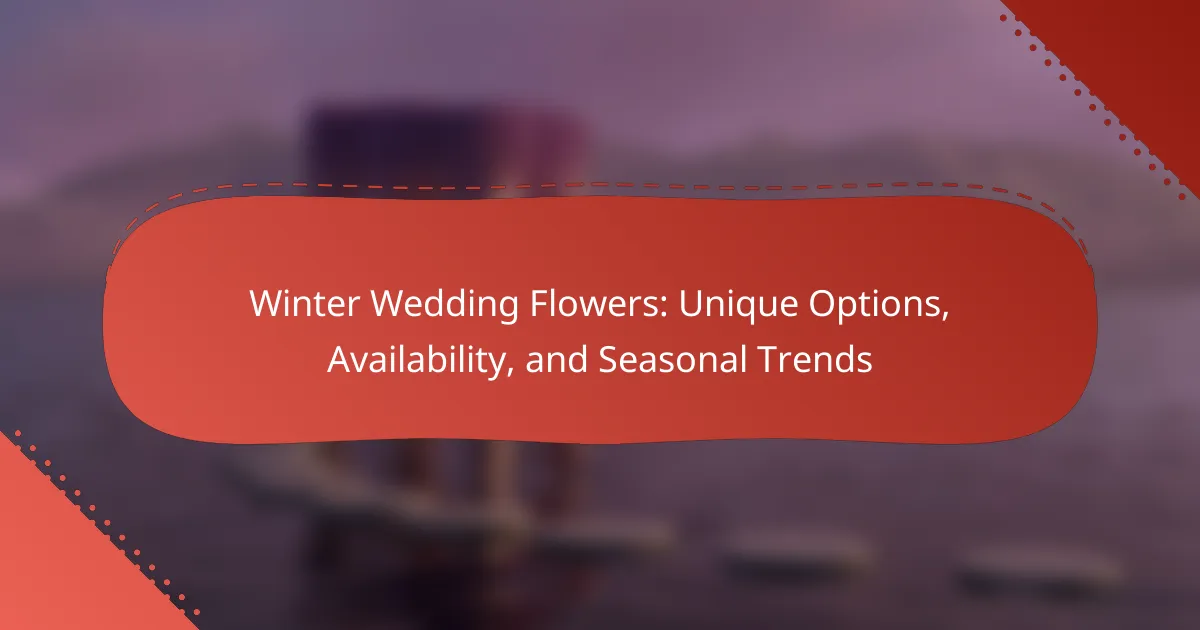
What are Winter Wedding Flowers?
Winter wedding flowers are floral arrangements specifically chosen for weddings held during the winter season. These flowers often include seasonal blooms such as poinsettias, amaryllis, and hellebores. Additionally, evergreens like pine and fir are popular for their festive appearance. Many couples opt for white, red, or deep jewel tones to complement winter themes. These flowers are available from local florists and specialty shops during the winter months. Seasonal availability ensures freshness and quality for winter weddings.
Why choose flowers for a winter wedding?
Flowers enhance the aesthetic of a winter wedding. They add color and vibrancy to the often-muted winter landscape. Seasonal blooms like poinsettias and amaryllis are readily available in winter. These flowers can evoke a festive atmosphere, making the event feel special. Additionally, flowers can be used in creative arrangements, such as centerpieces and bouquets. Their scent can also create a warm and inviting ambiance. Choosing flowers for a winter wedding allows couples to personalize their decor. This choice can reflect their unique style and preferences.
What unique characteristics do winter wedding flowers have?
Winter wedding flowers have unique characteristics that set them apart from flowers in other seasons. They often feature rich, deep colors like burgundy, navy, and dark green. Many winter flowers are hardy and can withstand colder temperatures. Varieties such as amaryllis, poinsettias, and hellebores are popular choices. Additionally, winter flowers may have a more sculptural or textural appearance. These flowers can also be combined with evergreen foliage for added visual interest. The availability of certain blooms may be limited, making seasonal options more special. Overall, winter wedding flowers bring a distinctive elegance to the occasion.
How do winter wedding flowers differ from those in other seasons?
Winter wedding flowers differ from those in other seasons primarily due to their availability and seasonal characteristics. Many flowers that thrive in warmer months are not available in winter. Instead, winter weddings often feature hardy blooms like roses, amaryllis, and anemones. These flowers can endure colder temperatures and still maintain their beauty. Additionally, winter arrangements may include evergreen foliage and seasonal accents like pinecones or berries. This combination creates a unique aesthetic distinct from spring or summer weddings, which typically showcase a wider variety of colorful blooms. The choice of flowers is influenced by the winter season’s limited options, leading to a more curated selection that emphasizes texture and depth.
What types of flowers are popular for winter weddings?
Popular flowers for winter weddings include roses, tulips, and amaryllis. Roses are available in various colors and symbolize love. Tulips offer a sleek shape and are often associated with spring but are also available in winter. Amaryllis features large, dramatic blooms that stand out in winter arrangements. Other notable choices are winter greenery, such as pine and eucalyptus. These elements add texture and complement the flowers well. Seasonal blooms enhance the overall aesthetic, making winter weddings unique and beautiful.
Which flowers are known for their availability in winter?
Winter flowers known for their availability include hellebores, winter jasmine, and pansies. Hellebores bloom during the cold months and can withstand frost. Winter jasmine produces yellow flowers and thrives in chilly conditions. Pansies are hardy and can flower even in snowy weather. These flowers are popular choices for winter weddings due to their resilience and beauty.
What are some unique options for winter wedding flowers?
Unique options for winter wedding flowers include anemones, hellebores, and winter jasmine. Anemones feature striking black centers and vibrant colors, making them visually captivating. Hellebores, also known as Christmas roses, bloom in various shades and add elegance to arrangements. Winter jasmine offers delicate yellow blooms, providing a cheerful touch during the cold season. Additionally, evergreen foliage, such as pine and cedar, can complement these flowers and enhance the winter theme. These unique options not only bring beauty but also reflect the season’s charm.
How can seasonal trends influence flower choices for winter weddings?
Seasonal trends significantly influence flower choices for winter weddings. In winter, couples often select flowers that are readily available and suited to the colder climate. Popular choices include winter blooms such as amaryllis, hellebores, and poinsettias. These flowers not only thrive in winter but also provide rich colors and textures. Seasonal trends also dictate the use of evergreen foliage, which adds depth and a festive feel to arrangements. Additionally, the demand for seasonal flowers can affect pricing and availability. Research indicates that flowers in season are often fresher and more vibrant, enhancing the overall aesthetic of winter weddings.
What are the current trends in winter wedding floral arrangements?
Current trends in winter wedding floral arrangements include the use of rich, deep colors like burgundy, navy, and emerald green. Popular flowers for winter weddings are anemones, ranunculus, and hellebores. Incorporating seasonal greenery such as pine, eucalyptus, and fir adds texture and depth. Many couples are opting for dramatic centerpieces that feature candles and metallic accents. Textured arrangements with berries and branches are also trending. Sustainable practices, like using locally sourced flowers, are increasingly popular. Additionally, dried flowers and preserved blooms are being embraced for their longevity and unique aesthetic. These trends reflect a desire for warmth and elegance during the winter season.
How do these trends reflect the overall wedding theme?
Winter wedding flower trends emphasize seasonal aesthetics and color palettes. These trends often incorporate rich hues like deep reds and greens, reflecting the winter landscape. Popular choices include evergreens, holly, and seasonal blooms like amaryllis. Such selections enhance the overall winter theme by creating a cozy and festive atmosphere. The use of locally sourced flowers also supports sustainability, aligning with modern wedding values. Additionally, trends like incorporating pinecones and berries add unique elements that resonate with winter motifs. Overall, these floral choices cohesively tie together the winter wedding theme, enhancing both visual appeal and emotional ambiance.

What is the availability of winter wedding flowers?
Winter wedding flowers are available, but options are limited compared to other seasons. Common winter flowers include poinsettias, amaryllis, and paperwhite narcissus. Seasonal greenery, such as pine, cedar, and eucalyptus, also enhances arrangements. Availability may vary by region and local florists. Many flowers can be sourced from greenhouses or imported. Some flowers, like roses and tulips, can be available year-round. However, seasonal blooms are typically more affordable and fresher. Florists often recommend choosing flowers that align with winter themes for the best aesthetic.
How does the climate affect the availability of winter flowers?
Climate significantly affects the availability of winter flowers. Cold temperatures can limit the growth and blooming of certain flower species. In regions with milder winters, more varieties can thrive and be available. Conversely, harsh climates may restrict options to hardier species. Additionally, precipitation levels influence soil moisture and plant health. For instance, excessive snow can protect some flowers from freezing, while drought conditions can hinder growth. Seasonal temperature fluctuations also impact flowering times. Understanding these factors is crucial for selecting winter flowers for events like weddings.
Which flowers are typically in season during winter?
Winter flowers typically in season include poinsettias, chrysanthemums, and hellebores. Poinsettias are popular for their vibrant red and green colors. Chrysanthemums offer a variety of colors and shapes. Hellebores, also known as Christmas roses, bloom in late winter. These flowers thrive in cold weather and are often used in winter arrangements. Their availability makes them suitable for winter weddings.
How can couples source winter flowers for their weddings?
Couples can source winter flowers for their weddings by exploring local florists, online flower shops, and farmers’ markets. Local florists often have seasonal arrangements tailored for winter weddings. Online flower shops provide a wide variety of options and delivery services. Farmers’ markets may offer locally grown winter blooms. Couples should also consider seasonal flowers like poinsettias, amaryllis, and hellebores, which are readily available in winter. Research indicates that using local and seasonal flowers can enhance the wedding’s aesthetic while supporting local growers.
What are the best practices for selecting winter wedding flowers?
The best practices for selecting winter wedding flowers include choosing seasonal blooms, considering color palettes, and ensuring availability. Seasonal blooms like poinsettias, amaryllis, and evergreens thrive in winter. Color palettes should reflect winter tones, such as whites, deep reds, and blues. Availability is crucial; some flowers may not be in season. Research indicates that using locally sourced flowers enhances freshness. Additionally, consider the durability of flowers in colder temperatures. Selecting flowers that complement the wedding theme also enhances overall aesthetics.
How can couples ensure they choose the freshest flowers?
Couples can ensure they choose the freshest flowers by selecting blooms that are in season. Seasonal flowers are typically harvested at their peak freshness. Couples should also inspect the flowers for vibrant colors and firm petals. Wilting or discolored petals indicate age. Additionally, checking for a strong fragrance can signify freshness. It’s advisable to purchase flowers from reputable local florists or farmers’ markets. These sources often provide freshly cut flowers compared to mass retailers. Finally, couples should ask about the delivery date to ensure flowers are as fresh as possible upon arrival.
What should couples consider when planning their floral budget?
Couples should consider flower types, quantity, and seasonal availability when planning their floral budget. Different flowers have varying costs based on their type. Seasonal flowers are often more affordable due to availability. Couples should also factor in delivery and setup fees, which can impact the overall budget. Additionally, they should consider the venue size, as larger venues may require more floral arrangements. Research shows that couples typically allocate 8-10% of their total wedding budget to flowers. This percentage can guide couples in setting a realistic budget.

What are some tips for using winter wedding flowers effectively?
Select seasonal flowers like poinsettias, amaryllis, and evergreens for winter weddings. These flowers are readily available and complement the winter theme. Incorporate rich colors such as deep reds, whites, and greens to enhance the seasonal aesthetic. Use natural elements like pinecones and berries to add texture and interest. Arrange flowers in unique vessels like lanterns or wooden boxes for a rustic touch. Consider using flowers that hold up well in colder temperatures to ensure longevity. Utilize floral foam to keep arrangements fresh and stable throughout the event. Finally, coordinate floral designs with winter-themed decor for a cohesive look.
How can couples incorporate winter flowers into their wedding decor?
Couples can incorporate winter flowers into their wedding decor by using seasonal blooms such as poinsettias, amaryllis, and hellebores. These flowers thrive in colder months and add rich colors to the decor. Arranging these flowers in centerpieces enhances table settings. Bouquets featuring winter flowers create a stunning visual for the bride. Additionally, using evergreens alongside winter flowers adds texture and greenery. Incorporating floral installations, like arches or backdrops, can make a striking statement. Utilizing winter-themed vases or containers complements the overall aesthetic. These elements create a cohesive winter wonderland atmosphere for the wedding.
What are some creative arrangements for winter wedding flowers?
Creative arrangements for winter wedding flowers include using seasonal blooms like amaryllis, poinsettias, and evergreens. These flowers can be combined in lush bouquets and centerpieces. Incorporating elements like pinecones and berries adds texture and interest. Consider using metallic accents, such as gold or silver vases, to enhance the winter theme. Cascading arrangements can create a dramatic effect, while compact arrangements work well for intimate settings. Utilizing clear glass containers can showcase the beauty of the flowers and highlight their colors against a winter backdrop. These arrangements not only reflect the season but also create a warm and inviting atmosphere.
How can lighting enhance the beauty of winter floral displays?
Lighting enhances the beauty of winter floral displays by highlighting colors and textures. Proper lighting can create depth and dimension in arrangements. Soft, warm lights can evoke a cozy atmosphere, complementing winter themes. Spotlights can draw attention to focal points within the display. Backlighting can create a glowing effect, making flowers appear more vibrant. Additionally, colored lights can transform the mood, adding a festive touch. Studies show that well-placed lighting can increase visual appeal by up to 30%. This enhancement is crucial for winter weddings, where floral displays play a significant role in overall aesthetics.
What common mistakes should be avoided when selecting winter wedding flowers?
Common mistakes to avoid when selecting winter wedding flowers include choosing flowers that are out of season. Many popular blooms, like peonies and garden roses, may not be available in winter. Ignoring the color palette can also lead to mismatched arrangements. Winter weddings often benefit from rich jewel tones or whites and greens. Additionally, underestimating the importance of texture can result in flat floral designs. Mixing various textures adds depth and interest to arrangements. Failing to consider the climate can affect flower longevity. Cold temperatures can impact how flowers hold up throughout the event. Lastly, neglecting to consult with a florist experienced in winter weddings can lead to uninformed choices. Expert guidance ensures that selections are both beautiful and appropriate for the season.
How can couples prevent last-minute changes in their floral arrangements?
Couples can prevent last-minute changes in their floral arrangements by planning well in advance. Establishing a clear vision for the floral design early in the wedding planning process is crucial. Regular communication with the florist ensures that any potential issues are addressed promptly. Couples should also confirm the order details a week before the wedding. Having a backup plan for flowers that may not be available is essential, especially for winter weddings. Additionally, couples should consider seasonal flowers to ensure availability. Research shows that advance planning reduces stress and increases satisfaction with floral arrangements.
What are the key factors to consider in flower longevity during winter?
Key factors to consider in flower longevity during winter include temperature, humidity, and light exposure. Cold temperatures can slow down a flower’s metabolic processes, extending its life. However, extreme cold can damage delicate blooms. Humidity levels are crucial; too much moisture can lead to rot, while too little can cause wilting. Proper light exposure is also important; flowers need indirect light to maintain vibrancy without being scorched. Additionally, the type of flower plays a significant role. Some varieties, like chrysanthemums and winter roses, are naturally more resilient in winter conditions. Proper care, including regular hydration and appropriate placement, can further enhance longevity.
Winter wedding flowers are floral arrangements specifically selected for weddings taking place during the winter season, featuring seasonal blooms such as poinsettias, amaryllis, and hellebores, along with evergreens like pine and fir. The article explores the unique characteristics of these flowers, their availability, and how they differ from blooms in other seasons. It highlights popular choices, current trends in floral arrangements, and best practices for selecting and incorporating winter flowers into wedding decor. Additionally, it addresses factors affecting flower longevity and tips for ensuring freshness, making it a comprehensive guide for couples planning winter weddings.
